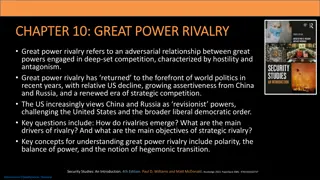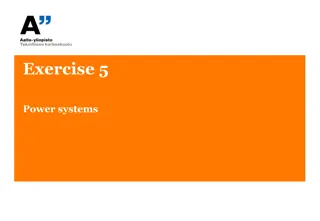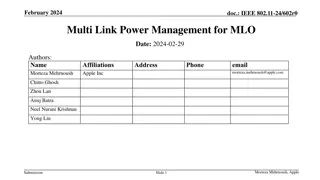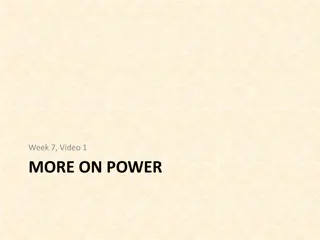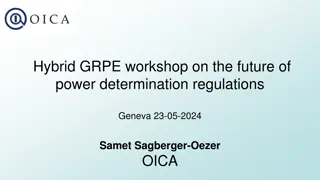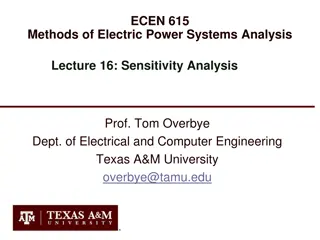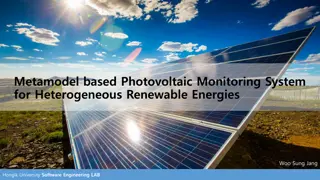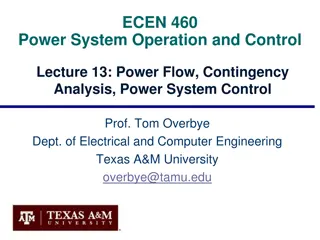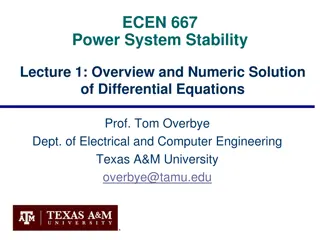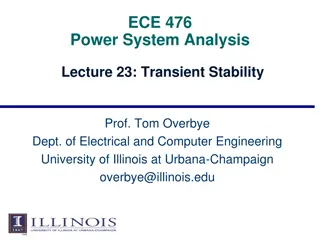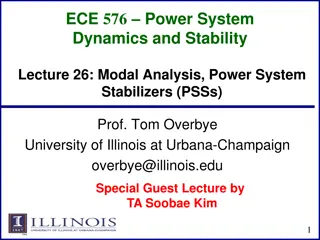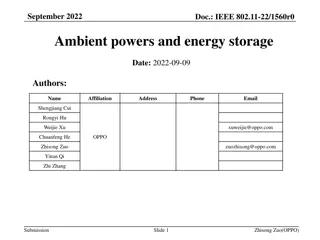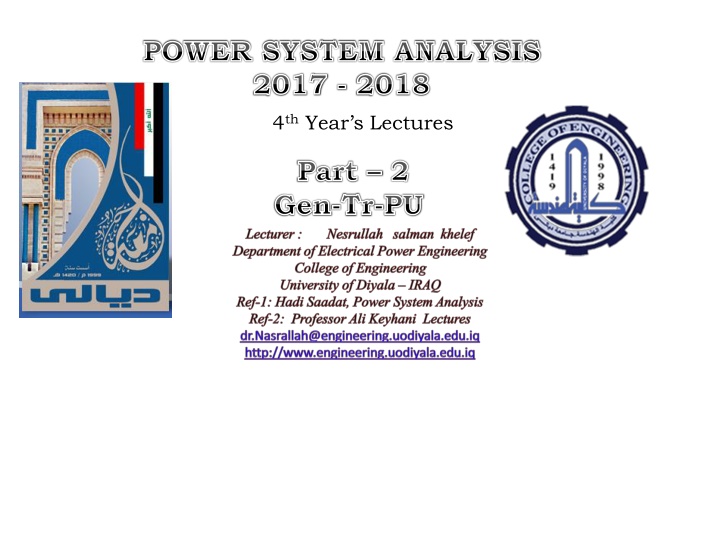
Power System Analysis 2017-2018: Lectures on Generator and Transformer Models
Explore the lectures on generator and transformer models in the power system analysis course for the academic years 2017-2018. Topics include per unit system, steady state characteristics, power factor control, and more. Dive into the world of power systems with Dr. Nasrallah.
Download Presentation

Please find below an Image/Link to download the presentation.
The content on the website is provided AS IS for your information and personal use only. It may not be sold, licensed, or shared on other websites without obtaining consent from the author. If you encounter any issues during the download, it is possible that the publisher has removed the file from their server.
You are allowed to download the files provided on this website for personal or commercial use, subject to the condition that they are used lawfully. All files are the property of their respective owners.
The content on the website is provided AS IS for your information and personal use only. It may not be sold, licensed, or shared on other websites without obtaining consent from the author.
E N D
Presentation Transcript
POWER SYSTEM ANALYSIS 2017 - 2018 4thYear s Lectures Part 2 Gen-Tr-PU dr.Nasrallah@engineering.uodiyala.edu.iq http://www.engineering.uodiyala.edu.iq
Lecture Outline Generator Model Transformer Model Per Unit System
Steady State Characteristics of Cylindrical Rotor Generator Power Factor Control ?3 =3V? = ? |??|cos? cd=?1sin?1= ????1cos?1
Power Transformer Equivalent Circuit
Determination of parameters/ SC Test Efficiency of Tr
Per-Unit System In the per-unit system, the voltages, currents, powers, impedances, and other electrical quantities are expressed on a per-unit basis by the equation: Actual value Quantity per unit = Base value of quantity S = V = S rated V b rated b Then compute base values for currents and impedances: S I = Z 2 V V b = = b b b V b I S b b b
Per-Unit System And the per-unit system is: V = . . I = actual V actual I V I u . . p u p b b Z S = = actual S actual Z Z S u . . u . . p p b b = . u % 100 % Z Z Percent of base Z . p
Example 1 An electrical lamp is rated 120 volts, 500 watts. If the voltage applied across the lamp is twice the rated value, compute the current that flows through the lamp. Use the per-unit method. Solution: Vb 120 = 240 V V = = = = ; 2 0 . ., 1 0 . . V p u Z p u . . p u . . p u 120 V b The per-unit equivalent circuit is as follows: = 1 0 . . Z p u = 2 0 . . VS p u V 2 0 . . p u = = = 2 0 . . I p u . . p u 1 0 Z . . p u = = = 2 0 . 4 167 . 8 334 0 I I I A 500= S u . . actual p b = = . 4 167 b I A b 120 V b
Per-unit System for 1- Circuit = V V One-phase circuits S Sb = line to neutral = V I 1 = where I I line current S = = b S I V V = V V = LV b bLV I bLV V HV bHV bHV bLV V bHV 2) V ( V 2) V ( V = = bLV bLV S Z = = bHV bHV S Z bLV I bHV I bLV b bHV b P = = cos P V I pu pu pu S S b = = * pu S V I pu pu S Q b = = sin Q V I pu pu pu S b
Transformation Between Bases Generally per-unit values given to another base can be converted to new base by the equations: S = 1 ( , , ) ( , , ) base P Q S P Q S _ _ _ 2 _ _ _ 1 pu on base pu on base S 2 base V = 1 base V V _ _ _ 2 _ _ _ 1 pu on base pu on base V 2 base 2 ( ) V S = 1 2 ( , , ) ( , , ) base base S R X Z R X Z _ _ _ 2 _ _ _ 1 pu on base pu on base 2 ( ) V 2 1 base base When performing calculations in a power system, every per-unit value must be converted to the same base.
Per-unit System for 1- Transformer Consider the equivalent circuit of transformer referred to LV side and HV side shown below: R X S+ S j R + jX 2 2 a a S S V V V V LV LV HV HV V N N N = = 1 1 LV a Define 1 2 V N S 2 HV (1) Referred to LV side (2) Referred to HV side
Per-unit System for 1- Transformer Choose: V V , S = Compute: V V = 1= Normal choose rated values as base values b LV rated S b rated 1 a = HV V V 2 1 1 b b b V LV 2 1 2 2 V V 1= 2= b b Z Z b b S S b b 2 1 2 1 Z V V = = = 2 1 b b b a 1 a 2 2 Z V 2 ( ) V 2 b b 1 b
Per-unit System for 1- Transformer Per-unit impedances are: jX R Z = + S S . 1 . u p Z 1 b R jX R jX + + S S S S + R jX 2 2 2 2 a a a a = = = S S Z . 2 . u p Z Z Z 1 b 2 1 b b 2 a Per-unit equivalent circuits of transformer referred to LV side and HV side are identical !! = Z Z So: 2 . u . 1 . u . p p
Per-unit Eq. Ckt for 1- Transformer R + jX S S S V N = = 1 1 LV a V N Z 2 HV N N 1 b 1 2 V V V V 1 2 LV b HV b Eq Ckt referred to LV side Z, Z, S pu S pu V V 1 2 b b V V 2 1 b b b S 1 : 1 Per-unit Eq Ckt referred to LV side
Per-unit Eq. Ckt for 1- Transformer X j a R S+ S S 2 2 a V N = = 1 1 LV a V N Z 2 HV 2 b N N 1 2 V V V V 1 2 LV b HV b Eq Ckt referred to HV side Z, Z, S pu S pu V V 1 2 b b V V 2 1 b b b S 1 : 1 Per-unit Eq Ckt referred to HV side .
Voltage Regulation Example A single-phase transformer rated 200-kVA, 200/400-V, and 10% short circuit reactance. Compute the VR when the transformer is fully loaded at unity PF and rated voltage 400-V. Solution: V V 1 . 0 j P S 2= = 400 200 = Vb Sb V kVA X S S load 1 0 S pu , load pu = j 1 . 0 X pu , S pu
Voltage Regulation Example Rated voltage: 0 . 1 = 0 V pu , S pu * * S 0 . 1 0 , load pu = = 0 . 1 = 0 I pu , load pu 0 . 1 0 V , S pu = + V = V I X , , , P 0 . 1 = pu pu 0 . 1 + S pu 0 S pu = + 0 j 1 . 0 1 j 1 . 0 7 . 5 o . 1 001 pu
Voltage Regulation Example Secondary side: = 0 . 1 = 0 V V pu , , pu full load S pu = . 1 = 7 . 5 o 001 V V pu , , pu no load P pu Voltage regulation: V V , , pu no load V pu full load = 100 % VR , pu full load 0 . 1 . 1 001 = = 100 % 1 . 0 % 0 . 1
Per-unit System for 3- Circuits Three-phase circuits S S 3 3 = V I = = = = = 3 Sb V V I 1 / 3 V where (line ) line to neutral L = I I = V V line current L , bHV = L HV 3 S V I = V V b L L , bLV L LV = = 3 3 S V I V I b bLV bLV bHV bHV
Per-unit System for 3- Circuits S I 3 S = = b b I bLV bHV 3 V V bLV bHV V 2) 3 V ( V V LV = = = bLV 3 bLV bLV S Z bLV I S LV b b 2) V ( = bHV S Z bHV b S * L 3 V I 3 = = = * pu L S V I pu pu S 3 V I b b b
Change Between Two Bases The impedances of generators, transformers and motors supplied by manufacturers are generally given in per-unit values on own ratings. For analysis all impedances must be expressed on common base
Example #1 for 3- Transformer Three 25-kVA, 34500/277-V transformer connected in -Y. Short-circuit test on high voltage side: = 2010 V V , Line SC . 1 = 26 I A , Line SC = 912 P W 3 , SC Determine the per-unit equivalent circuit of the transformer.
Solution (a) Using Y-equivalent R + jX . 1 = 26 I S S SC 2010 = 25000 = Sb VA V SC 3 34500 277 3 2010= = 1160 47 . VSC V 3 1160 47 . = = 921 00 . Z SC . 1 26
Solution P 304 912= = = = = 191 48 . 304 R P W S 2 SC 2 . 1 26 3 I 2 = = = 2 S 2 2 921 191 48 . 900 . 86 X Z R S SC So = + 191 . 48 900 . 86 ZSC j 34500 = = = 19918 58 . V V 25000 Sb VA , b HV 3 2 19918 58 . = = 15869 99 . Z ,HV b 25000 + 191 48 . 900 86 . j = = + . 0 012 j . 0 0568 Z pu , Y , SC pu 15869 99 .
Solution (b) Using -equivalent . 1 26 = I Z SC 3 , SC = 25000 Sb VA = 2010 V SC 34500 277 . 1 26 = = = . 0 727 ISC A 2010 VSC V 3 2010 = = 2764 . 79 Z , SC . 0 727
Per-unit System for 3- Transformer P 304 912= = = = = 575 18 . 304 R P W , S 2 SC 2 . 0 727 3 I 2 = = = 2 S 2 2 2764 79 . 575 18 . 2704 30 . X Z R , , , S SC So = + 191 . 48 900 . 86 ZSC j = = 34500 V V 25000 Sb VA , b HV 345002 = = 47610 Z ,HV b 25000 + 575 18 . 1704 30 . j = = + . 0 012 j . 0 0568 Z pu , , SC pu 47610
Problem 1 100 j G 20 kV 22kV/220kV 80MVA 14% 220kV/20kV 50MVA 10% 50MVA 0.8 PF lagging Select Vbase in generator circuit and Sb=100MVA, compute p.u. equivalent circuit.


